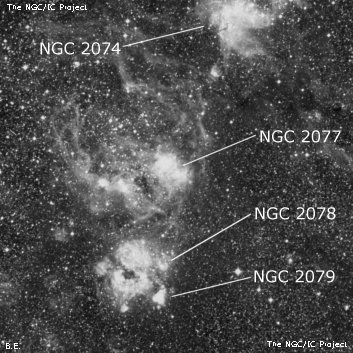
NGC 2085 and 2086, a smaller pair of bright HII glows, lie 3' and 4' ESE, and the entire collection forms LMC-N160. In addition, a bright complex of HII knots including NGC 2078, 2079, 2083 and 2084 (LMC-N159 and O-association LW 105) lies 5' S. Together these groups form a stunning field about 35' SSE of the Tarantula Nebula.
John Herschel discovered NGC 2077 = h2947 in Dec 1834 (exact sweep date unknown) and described as "The preceding two forming a double nebula. The place deduced from that of the following and brighter [NGC 2080 = h2950], by Delta RA = 7.1sec, Delta NPD = 20", as they result from the drawing of Dec 4, 1837. Pl III, figure 4."
James Dunlop discovered the entire complex (D 145) on 24 Sep 1826 and recorded "This is the centre of a large cluster of extremely minute stars, with many very small nebulae in it." His position is just 4' SE of[NGC 2080. As NGC 2077 has a high surface brightness, it was likely picked up as one of the "very small nebulae in it."
600/800mm - 24" (4/9/08 - Magellan Observatory, Australia): this is the southwest component of a very bright, impressive 2' emission patch with NGC 2080. At 200x and UHC filter, NGC 2077 appeared bright, moderately large, elongated 2:1 E-W, ~1.2'x0.6'. Without a filter, three fainter stars are involved in the glow (one is a massive Wolf-Rayet star Brey 93a). Forms a close pair with NGC 2080 (Ghost Head Nebula) 1.1' NE.
Notes by Steve Gottlieb